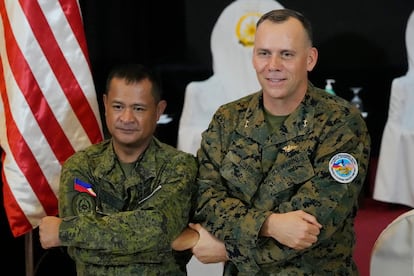US, Philippines hold largest war drills near disputed waters
The annual drills by the longtime treaty allies called Balikatan — Tagalog for ‘shoulder-to-shoulder’ — will run up to April 28 and involve more than 17,600 military personnel

American and Filipino forces on Tuesday launched their largest combat exercises in decades in the Philippines and its waters across the disputed South China Sea and the Taiwan Strait, where Washington has repeatedly warned China over its increasingly aggressive actions.
The annual drills by the longtime treaty allies called Balikatan — Tagalog for “shoulder-to-shoulder” — will run up to April 28 and involve more than 17,600 military personnel. It will be the latest display of American firepower in Asia, as the Biden administration strengthens an arc of alliances to better counter China, including in a possible confrontation over Taiwan, an island democracy that Beijing claims as its own.
That dovetails with efforts by the Philippines under President Ferdinand Marcos Jr. to defend its territorial interests in the South China Sea, which China claims virtually in its entirety, by boosting joint military exercises with the U.S. and allowing rotating batches of American forces to stay in additional Philippine military camps under a 2014 defense pact.
“The relationships that we have, that we build into these exercises, will make us faster to respond to conflict, crisis, humanitarian assistance and disaster relief,” U.S. Marine Maj. Gen. Eric Austin said.
About 12,200 U.S. military personnel, 5,400 Filipino forces and 111 Australian counterparts are taking part in the exercises, the largest since Balikatan started three decades ago. The drills will showcase U.S. warships, fighter jets as well as Patriot missiles, HIMARS rocket launchers and anti-tank Javelins, according to U.S. and Philippine military officials.
In a live-fire drill the allies will stage for the first time, U.S. and Filipino forces will sink a target ship in the Philippine territorial waters off the western province of Zambales on April 26, in a coordinated inland and coastal artillery bombardment and airstrike, Col. Michael Logico, a Philippine spokesman for Balikatan, told reporters.
“We have to fire at a target that is closer to what we would expect in an actual threat, which is an intrusion coming from an adversary by sea,” Logico told reporters. “We are demonstrating that we are combat ready.”
Asked if Marcos raised any concern that Beijing may be antagonized by the rocket-firing near the busy waterway that China considers its territory, Logico said that did not come up when he briefed the president about the event. Marcos wants to witness the live-fire drill, he said.
In western Palawan province, which faces the South China Sea, the exercises will involve retaking an island captured by enemy forces, Logico said.
Philippine military officials said the maneuvers were aimed at bolstering the country’s coastal defense and disaster-response capabilities and were not aimed at any country.
Such field scenarios will “test the allies’ capabilities in combined arms live-fire, information and intelligence sharing, communications between maneuver units, logistics operations, amphibious operations,” the U.S. Embassy in Manila said.
In a sign of deepening defense cooperation, the Philippine foreign and defense secretaries will meet their American counterparts in Washington on Tuesday to discuss the American military presence and proposed joint naval patrols, officials said.
Washington and Beijing have been on a collision course over the long-seething territorial disputes involving China, the Philippines and four other governments, and Beijing’s goal of annexing Taiwan, by force if necessary.
China last week warned against the intensifying U.S. military deployment to the region. Chinese Foreign Ministry spokesperson Mao Ning said in a regular news briefing in Beijing that it “would only lead to more tensions and less peace and stability in the region.”
The Balikatan exercises opened in the Philippines a day after China concluded three days of combat drills that simulated sealing off Taiwan, following Taiwanese President Tsai Ing-wen’s meeting with House Speaker Kevin McCarthy last week in California that infuriated Beijing.
On Monday, the U.S. 7th Fleet deployed guided-missile destroyer USS Milius within 12 nautical miles off Mischief Reef, a Manila-claimed coral outcrop which China seized in the mid-1990s and turned into one of seven missile-protected island bases in the South China Sea’s hotly contested Spratlys archipelago. The U.S. military has been undertaking such freedom of navigation operations for years to challenge China’s expansive territorial claims.
“As long as some countries continue to claim and assert limits on rights that exceed their authority under international law, the United States will continue to defend the rights and freedoms of the sea guaranteed to all,” the 7th Fleet said.
Sign up for our weekly newsletter to get more English-language news coverage from EL PAÍS USA Edition
Tu suscripción se está usando en otro dispositivo
¿Quieres añadir otro usuario a tu suscripción?
Si continúas leyendo en este dispositivo, no se podrá leer en el otro.
FlechaTu suscripción se está usando en otro dispositivo y solo puedes acceder a EL PAÍS desde un dispositivo a la vez.
Si quieres compartir tu cuenta, cambia tu suscripción a la modalidad Premium, así podrás añadir otro usuario. Cada uno accederá con su propia cuenta de email, lo que os permitirá personalizar vuestra experiencia en EL PAÍS.
¿Tienes una suscripción de empresa? Accede aquí para contratar más cuentas.
En el caso de no saber quién está usando tu cuenta, te recomendamos cambiar tu contraseña aquí.
Si decides continuar compartiendo tu cuenta, este mensaje se mostrará en tu dispositivo y en el de la otra persona que está usando tu cuenta de forma indefinida, afectando a tu experiencia de lectura. Puedes consultar aquí los términos y condiciones de la suscripción digital.
More information
Archived In
Últimas noticias
The complicated life of Francesca Albanese: A rising figure in Italy but barred from every bank by Trump’s sanctions
From digital curfews to blocking apps: How technology experts protect their children online
Why the price of coffee has skyrocketed: from Brazilian plantations to specialty coffee houses
Confined to a Cuban hospital: When electricity is a matter of life or death
Most viewed
- Pablo Escobar’s hippos: A serious environmental problem, 40 years on
- Why we lost the habit of sleeping in two segments and how that changed our sense of time
- Trump’s obsession with putting his name on everything is unprecedented in the United States
- The Florida Keys tourist paradise is besieged by immigration agents: ‘We’ve never seen anything like this’
- Charles Dubouloz, mountaineering star, retires at 36 with a farewell tour inspired by Walter Bonatti










































